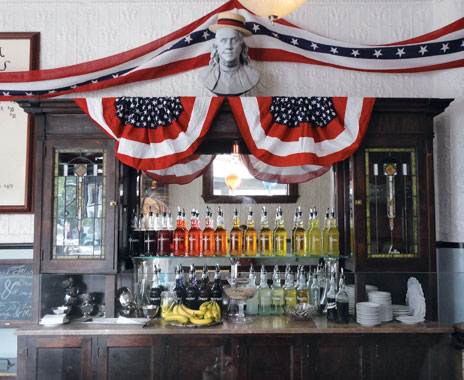Call it a reflection of consumers’ growing desire for local fare or their increasing demand for cleaner food with minimal processing and fewer ingredients. But one thing is for sure in foodservice today: What’s old is most decidedly new again.
Both brands and customers are returning to an old-school approach to foodservice, and it’s not just about sourcing local products or crafting menus made with old-world approaches and processes, though that does play a big part. No, it’s a do-it-yourself mindset combined with additional nostalgic factors—authentic soda jerk uniforms at an old-school ice cream parlor, for example, or a seafood concept that still operates in a decades-old seaside shack—that’s separating a growing crop of limited-service concepts from the rest. While simplifying their products and processes by going back to the old-school way of making and serving food, these restaurants are amplifying the dining experience in the most modern way possible.
Here are four brands using traditional approaches to food making, sourcing, branding, and more in a way that’s all at once both old and new.
Beecher’s Handmade Cheese
Locations: Seattle and New York City
Founded: 2003
Specializes in: Handcrafted cheeses from local dairy sources
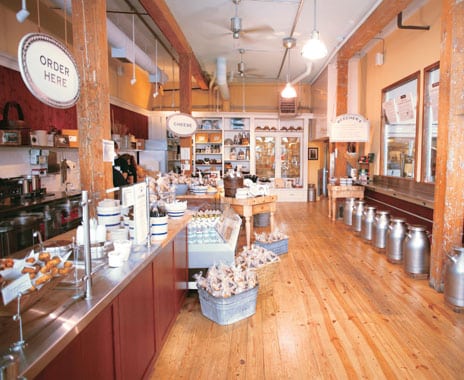 For Beecher’s Handmade Cheese founder Kurt Beecher Dammeier, what started as a fondness for cheese that developed while he traveled through Europe in his early 20s blossomed in the early 2000s into a wildly popular destination for Seattle cheese lovers with a taste for artisan creations and handmade varieties with no processed ingredients. Using local dairy sources and traditional cheese-making methods to create each of its cheeses, Beecher’s goes against what Dammeier calls the “commodity Cheddar-ization” that’s become common throughout the foodservice industry.
For Beecher’s Handmade Cheese founder Kurt Beecher Dammeier, what started as a fondness for cheese that developed while he traveled through Europe in his early 20s blossomed in the early 2000s into a wildly popular destination for Seattle cheese lovers with a taste for artisan creations and handmade varieties with no processed ingredients. Using local dairy sources and traditional cheese-making methods to create each of its cheeses, Beecher’s goes against what Dammeier calls the “commodity Cheddar-ization” that’s become common throughout the foodservice industry.
The cheeses, crafted behind a glass window within each store, are aged for a minimum of 20 months using just two ingredients: milk and bacteria. “We get our flavor naturally by actually aging it for a long time,” Dammeier says. “A lot of cheeses in our world aren’t like that.” Its cheese lineup regularly includes Beecher’s award-winning Flagship cheese, its peppery Marco Polo variety, and its whole-milk Just Jack, alongside a number of other artisan cheeses.
With an old-world, turn-of-the-century-style logo and a store design that gives off distinct vibes of an old general store, Beecher’s brand and products—which include not only the cheese it makes, but also sandwiches and an Oprah Winfrey favorite, Beecher’s World Famous Mac & Cheese—naturally evoke a yester-year feeling for customers, Dammeier says.
By bringing back an age-old, five-step cheese-making process and doing it where customers can watch it happening, he says, Beecher’s hopes to encourage guests to think about where and how all of their food is made. This old-school philosophy in regards to transparency is also the key to building a trusting relationship between the brand and its customers, Dammeier says.
“It’s a full-on demonstration that they can trust us, because we’re making it right in front of them. And I take that very seriously. I think that trust is really the only thing that you have as a brand,” he says. “We operate our company in such a way that says we just never want to breach that trust.”
Cochon Butcher
Location: New Orleans
Founded: 2009
Specializes in: House-made meats
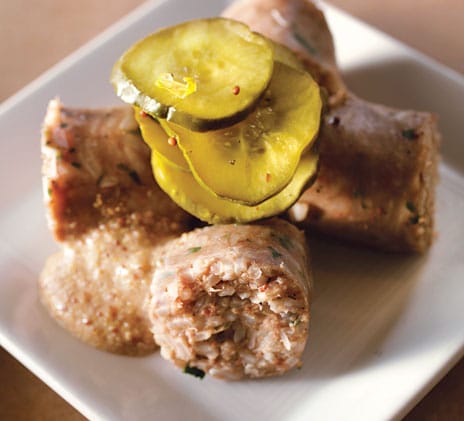 An offshoot of New Orleans–based Cajun restaurant Cochon, Cochon Butcher has been slicing up old-world magic in its meat shop and wine bar since debuting in early 2009.
An offshoot of New Orleans–based Cajun restaurant Cochon, Cochon Butcher has been slicing up old-world magic in its meat shop and wine bar since debuting in early 2009.
“We really wanted to do something of the same caliber as we do in our high-end restaurants in a casual atmosphere,” says Stephen Stryjewski, chef and owner of Cochon Butcher, as well as fine-dining concepts Cochon, Calcasieu, and Pêche Seafood Grill. “Things taste a lot better when you’re using higher-quality ingredients and artisanal methods and highly trained people.”
From the sourcing of grass-fed, heritage-breed pigs to the use of less-refined products and ingredients, the butcher shop’s artisanal, old-school methods appeal to consumers’ increasingly sophisticated tastes and desire to return to the simplicity of the past, Stryjewski says.
The shop, which consists of both a meat counter and a fast-casual dining area, uses entire pigs to create various meat cuts, such as Andouille sausage, chorizo, sopressata, merguez, and more. It also presents guests with an entire menu of café offerings like pork belly sandwiches and Le Pig Mac, a twist on McDonald’s Big Mac made with two pork patties, lettuce, cheese, pickle, onion, and a special sauce on a sesame seed bun.
Stryjewksi says every ingredient in Cochon Butcher, with the exception of canned tomatoes in the winter, is made within the store. For the Reuben sandwich, for example, the butchery uses house-baked marble rye bread, house-made pastrami that’s brined for 10 days and smoked for more than eight hours, sauerkraut made from cabbage that’s fermented for two weeks, and mustard that includes special ingredients like apple cider vinegar, tarragon, and rosemary.
“It just makes a better sandwich when someone has put that much thought and care into it,” he says.
The brand’s customer-service approach is traditional, too. “We really try to concentrate on customer service and try, from the minute people walk in the door, to greet them and have people who work behind the counter selling them meats who are knowledgeable—not only in what they’re selling, but in how to prepare [the meats],” Stryjewski says.
The concept also incorporates small touches like modified table service to instill the level of service that guests were accustomed to in the old days. “People still order at the counter initially and then their food is delivered,” he says. “We’ll leave their checks open, so if they want more cocktails or another round of drinks, we offer that through table service instead of making people get up and get back in line.”
[pagebreak]
The Franklin Fountain
Location: Philadelphia
Founded: 2004
Specializes in: Handcrafted shakes, sundaes, and sodas
They may be operating a 10-year-old ice cream parlor and soda fountain in the home of the ice cream soda, but brothers Eric and Ryan Berley’s passion for all things old school, historic, and antique dates all the way back to their childhood. And after the Berley family acquired a building in the Old City neighborhood of Philadelphia, the brothers knew they wanted to create an of-the-past concept based on one of America’s oldest traditions: the soda fountain.
Spending more than two years scouring the country for antique ice cream parlor relics and learning first-hand how to create small-batch, artisan ice cream, the duo finally opened its nostalgic ice cream parlor and soda fountain in the summer of 2004.
Ryan Berley says America’s craving for community and cultural identity paved the way for the wild success and growth The Franklin Fountain has seen over its first decade in business. “We don’t have thousands of years of American traditions,” he says. “We have 200, and the soda fountain was one of those things that was an American tradition. We wanted to bring that back and salvage it.”
Handmade ice cream and sodas are at the core of The Franklin Fountain, and are, in and of themselves, nostalgic treats that consumers of all ages enjoy, Berley says. “It speaks to our childhood,” he says. “You remember your favorite flavor when you were little, and you might still really like that flavor, and it brings back floods of positive memories.”
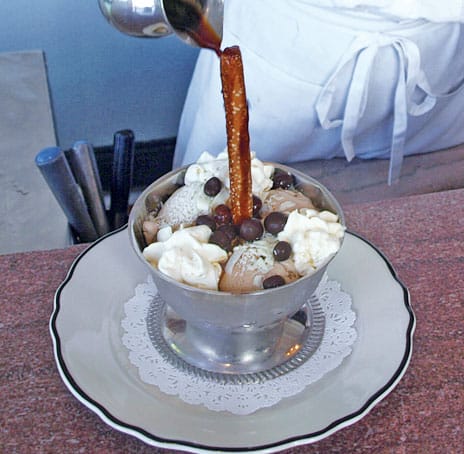 At The Franklin Fountain, everything from the brand’s hot fudge and peanut butter sauce to its dozens of soda flavors are made in-house, while each batch of ice cream is crafted with dairy from a local farm that’s been in business since the 1920s.
At The Franklin Fountain, everything from the brand’s hot fudge and peanut butter sauce to its dozens of soda flavors are made in-house, while each batch of ice cream is crafted with dairy from a local farm that’s been in business since the 1920s.
“You can buy bases and just use them in the ice cream, and we did some of that in the beginning. But now we’re making practically all of our bases from scratch,” Berley says. “It makes the product extra special.”
Though the antique marble soda fountain and vintage wooden tables are the centerpiece of the parlor’s interior, everything from The Franklin Fountain’s signage and branding to its products and authentic soda-jerk uniforms combine to create an instant sense of nostalgia for any customer stepping through the door.
The brothers and the brand’s graphic designer also study menus, fonts, and other design features from ice cream parlors of the past to make each element of the brand as authentic as possible. “We’re sort of drawing on these other traditions and referencing them in our menu,” Berley says. “We like to tell the stories of the past.”
But perhaps the biggest selling point in the brand’s old-school approach is that nothing about the soda fountain is phony. “It’s a reflection of who we are. It was really natural to create this period experience,” Berley says. “It’s not a show, in the way that Disney is a show. It’s more like, ‘This is who we are.’”
The Clam Shack
Location: Kennebunk, Maine
Founded: 1968
Specializes in: Fresh-caught lobster, clams, and other seafood
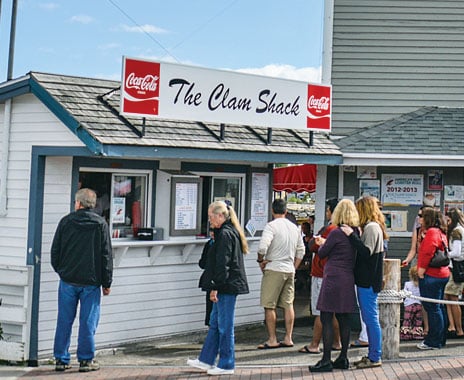 Everyone has those childhood memories of summers by the beach, spending days swimming in the ocean and nights digging into huge piles of seafood with family and friends. It’s a nostalgic image and emotion many brands would kill to evoke in their customers, but it’s one that Maine-based concept The Clam Shack evokes without even trying.
Everyone has those childhood memories of summers by the beach, spending days swimming in the ocean and nights digging into huge piles of seafood with family and friends. It’s a nostalgic image and emotion many brands would kill to evoke in their customers, but it’s one that Maine-based concept The Clam Shack evokes without even trying.
The seafood shack, which sits directly beside a fish market founded in 1938, is what owner Steve Kingston calls a classic New England takeout, where every fresh-caught item is served up to-go for guests to enjoy at wooden picnic tables and lobster crates or sitting along the Kennebunk River’s boardwalk.
Kingston, who took over The Clam Shack in 2000, has worked hard to keep the decades-old restaurant as authentic as it was the day it opened in 1968, whether that’s through upkeep of the original shanty—which still has floorboards dating back to the early 1900s—or sourcing lobster straight from local fishermen. “We’re constantly updating the building to some degree, but we’re very careful to make sure that it’s as authentic as possible,” Kingston says. “The sources have never changed either. Fresh lobster has been coming in the building since the early 1900s, and there’s no reason to change that.”
And Kingston isn’t talking “fresh” lobster that’s wheeled in on massive tractor-trailers from a processor hundred of miles away. “My guy shows up in his pickup truck and unloads five crates of fresh lobster,” he says. “We open up the crates and all the tourists ‘ooh’ and ‘ahh,’ and it’s the real deal. That isn’t coming in a frozen box. That’s not coming from a processing plant down east somewhere. That’s as real as it gets.”
When it comes to some of the other items The Clam Shack serves, the restaurant attempts to keep them as local as possible, too, though it sometimes has to source products like scallops and haddock from Boston and Canada due to strict fishing regulations.
Despite the popularity of clams, whole lobster, Maine shrimp, and other seafood specialties, Kingston says, it’s the classic lobster roll that fans and food critics rave about. The Clam Shack sells 400–500 lobster rolls on an average summer day.
No matter the product, authenticity is the top priority for the East Coast concept, though taste is a close second. “Someone sees it, they bite into the food, and they’re like, ‘Oh my word. I had lobster up and down the coast; why is yours so much better?’” Kingston says. “We have them fresh. We cook them in salt water that comes right out of the river. We have the whole thing, the real deal.”

